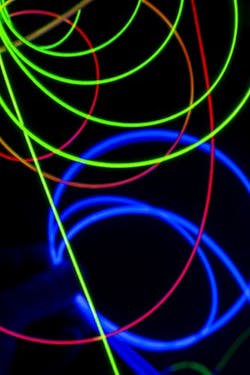New optical fibers distribute light like miniature neon tubes
Fibrance is the term coined by Corning Incorporated (Corning, NY) for its new optical fibers that distribute a variety of wavelengths of light evenly along their length, much like very tiny and flexible neon tubes. These fibers have nanostructures in the glass core with a standard diameter of ~125 to 200 μm, surrounded by a polymer cladding, that allow the fibers to emit light uniformly across customizable lengths. Standard diffusion lengths are 1, 5, and 10 m, with 50 m lengths possible. For high-power or ultraviolet emission, a glass rather than polymer cladding can be used to efficiently emit these wavelengths.
Light-diffusing Fibrance contains a ring of nonperiodically radially and axially distributed scattering nanostructures with diameters of ~50–500 nm. These wavelength-independent scattering centers enable scattering losses as high as 5–7 dBm in fibers with bend radii as small as 5 mm. Large core size and high numerical aperture (0.35 to 0.53) allows low-loss coupling from visible, near-IR, or UV laser diodes. Coupling to LEDs is possible if the fibers are bundled together with a coupling-efficiency tradeoff. Phosphor coatings on the surface of the fiber can be used to change the scattered color or produce white light for display, aesthetic, and industrial illumination applications. Contact Vineet Tyagi at[email protected].

